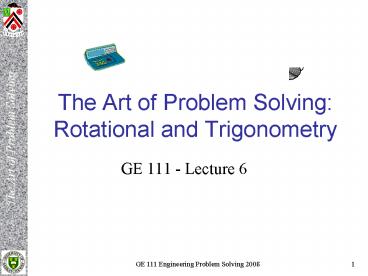The Art of Problem Solving: Rotational and Trigonometry - PowerPoint PPT Presentation
1 / 14
Title:
The Art of Problem Solving: Rotational and Trigonometry
Description:
A bicycle wheel has a 28.0-in diameter wheel and is rotating at 195 RPM. ... How far will the bicycle travel (miles) in 45.0 minutes and what will be the ... – PowerPoint PPT presentation
Number of Views:102
Avg rating:3.0/5.0
Title: The Art of Problem Solving: Rotational and Trigonometry
1
The Art of Problem SolvingRotational and
Trigonometry
- GE 111 - Lecture 6
2
How do you solve problems?
Recognize and Understand the Need
Accumulate Data and Verify Accuracy
Select the Appropriate Theory or Principle
Make Necessary Assumptions
Solve the Problem
Verify and Check Results
Communicate the Results
3
How do you solve problems?
- In essence ask yourself
- What is the purpose of this problem?
- What do I need to know to solve the problem?
- What resources do I have at my disposal?
- How do I get from what I have, to what I need to
know? - Exploration may be required
- Learning to see paths to a solution requires
practice, persistence, and pain (unfortunately). - Problem solving is not learned by copying others
work all problems are different.
4
How do you understand problems?
- Expand (ab)n.
5
How do you understand problems?
5
6
How do you understand problems?
7
Rotational Problem 1
- If you are traveling 65 mph, what is your angular
axle speed in RPM? Assume a tire size of
P235/75R15, which has an approximate diameter of
30.0 in.
8
Rotational Problem 2
- The wheel of an automobile turns at the rate of
195 RPM. Express this angular speed in (a)
revolutions per second and (b) radians per
second. If the wheel has a 30.0-in diameter,
what is the velocity of the auto in miles per
hour?
9
Rotational Problem 3
- A bicycle wheel has a 28.0-in diameter wheel and
is rotating at 195 RPM. Express this angular
speed in radians per second. How far will the
bicycle travel (miles) in 45.0 minutes and what
will be the velocity in miles per hour?
10
Feedbacks from the Marker
- Assigments must be neat and legible.
- Students must show all their work to get full
marks. - Must have a title page INCLUDING their class
section. - Box all final answers.
- Use pencil, not pen.
- Use problem paper, not looseleaf.
- NEVER write on the backsides of paper
- Use plenty of space for each problem.
- Possibly copy out the initial question before
starting to answer the question.
11
In Class Problems
- These problems deal with geometry!
- Remember to always make of a sketch of the
problem before starting. (And make it big and
clear enough to see and to brainstorm on!)
12
Geometry Problem 1
A kite string forms an angle of 42 withthe
ground when the entire 800 ft of stringis used.
What is the kites elevation?
13
Geometry Problem 2
An 80-ft pole is stabilized by guide wireswhich
run from the top of the pole to theground. The
wires are located 15 ft from thebase of the
pole. What length of wire isrequired? What is
the angle that the wiremakes with the ground?
14
Geometry Problem 3
A diagonal of a parallelogram has lengthof 60
in. and makes an angle of 20 with oneof the
sides. The side has a length of 25 in.Determine
the length of the other side.































